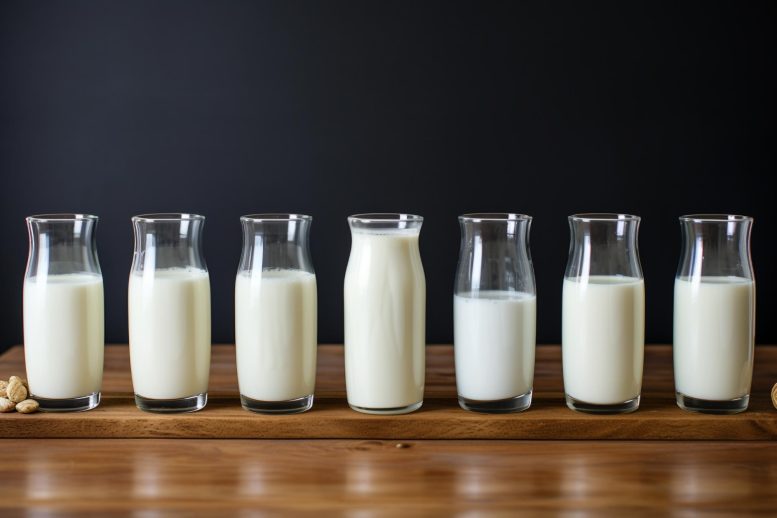
A study analyzing over 200 plant-based milk products found that only 12% matched or surpassed the calcium, vitamin D, and protein content of cow’s milk. The majority of these alternatives, particularly those made from oats, soy, and almonds, were fortified with calcium and vitamin D. However, only 16% of these plant-based options had protein levels equal to or greater than cow’s milk. The study highlights the need for clearer labeling and public guidance on nutritional differences.
An analysis of 200+ plant-based milk alternatives finds few contain the calcium, vitamin D, and protein of cow’s milk.
More and more people are turning to plant-based milk alternatives, with oats, soy, and almonds being popular choices. But there’s a question to consider: do these plant-based products offer the same nutritional benefits as cow’s milk? A recent study indicates that, in most cases, they do not.
Cow’s milk has long been a primary source of calcium and vitamin D. These nutrients are flagged by the 2020-2025 Dietary Guidelines for Americans as commonly underconsumed, putting public health at risk. Additionally, cow’s milk serves as a significant protein contributor to the American diet.
Findings from the Study
To assess how the nutritional content of plant-based milk alternatives compares to that of cow’s milk, scientists examined more than 200 plant-based milk alternative products being sold in the U.S. in 2023. This was far more products than were included in previous studies. Compared to cow’s milk, only 12% of the milk alternative products contained comparable or greater amounts of all three nutrients studied: calcium, vitamin D, and protein.
Abigail Johnson, assistant professor and associate director of the University of Minnesota School of Public Health Nutrition Coordinating Center, presented the findings at NUTRITION 2023, the annual flagship meeting of the American Society for Nutrition.
“Our results provide evidence that many plant-based milk alternatives are not nutritionally equivalent to cow’s milk,” said Johnson. “Based on these findings, consumers should look for plant-based milk alternative products that list calcium and vitamin D as ingredients. They may also want to consider adding other sources of calcium and vitamin D to their diets.”
Diving Deeper into the Data
The University of Minnesota’s Nutrition Coordinating Center maintains a database of approximately 19,000 foods for assessing dietary intake in human research. “We know from our dietary assessments for nutrition studies that consumers are choosing more plant-based milk alternatives,” said Johnson. “This project aimed to increase the number of these milk alternatives available in the Nutrition Coordinating Center’s database of foods.”
The study included nutrition information from nutrition facts labels and ingredient information for 233 plant-based milk alternative products from 23 different manufacturers. For each product, the researchers applied a nutrient calculation program to estimate full nutrient information. They then compared the nutritional content of different products within a category — for example, almond milk, oat milk, and soy milk — to each other and to cow’s milk. Compared to dairy milk, just 28 of the plant-based alternatives had similar or more calcium, vitamin D, and protein.
Key Points from the Analysis
Almost two-thirds of the products included in the study were made from almonds, oats, or soy. The researchers found that 170 of the plant-based milk alternatives were fortified with both calcium and vitamin D and that the level of fortification tended to be similar to dairy milk. Specifically, 76% of the oat-based products, 69% of soy-based, and 66% of almond-based alternatives were fortified with both calcium and vitamin D. The median protein content was 2.0 grams (g) of protein per 240 milliliters (ml) of liquid, with a large variability that ranged from 0 to 12 g. Only 38 (16%) of the milk alternatives studied had a protein level greater than or equal to the 8 g per 240 ml found in cow’s milk. Soy- and pea-based alternatives were more likely to have higher protein.
“Our findings point to a need to ensure that consumers are aware that many plant-based milk alternative products in the marketplace today are not nutritionally equivalent to cow’s milk,” said Johnson. “Product labeling requirements and dietary guidance to the public are among the approaches that may be helpful in alerting and educating consumers.”
Future Research Directions
Next, the researchers plan to explore other nutrients in plant-based milk alternatives that make them different from cow’s milk. For example, many of these products contain fiber, suggesting that they may help meet some nutritional needs that cow’s milk doesn’t.









I would just like to mention something as a vegan for over 14 years. Informed vegans NEVER expect to get the same nutrients from almond milk as from cows milk. We get it from our greens as cows should. The veg milks are just a familiar food to enjoy. We know to get our nutrients from nuts, seeds,grains and veggies. It’s not really necessary to compare them as we don’t rely on plant milk to be exactly the same, nutritionally speaking. It’s just a food to enjoy. Factory farmed cows aren’t getting the nutrients you enjoy from the greens that would be their natural diet but rather supplements in their feed. So they put some of those nutrients in the plant milks but idk any vegan that drinks plant milk for their calcium. That’s just silly. It’s a simple idea but I keep seeing these studies comparing these products and that’s just not how we eat. We eat veggies for nutrients. Junk food vegans are a thing too but these folks aren’t eating for health. The standard American diet is so so unhealthy, it’s odd to try to tarnish a vegan diet with these studies.